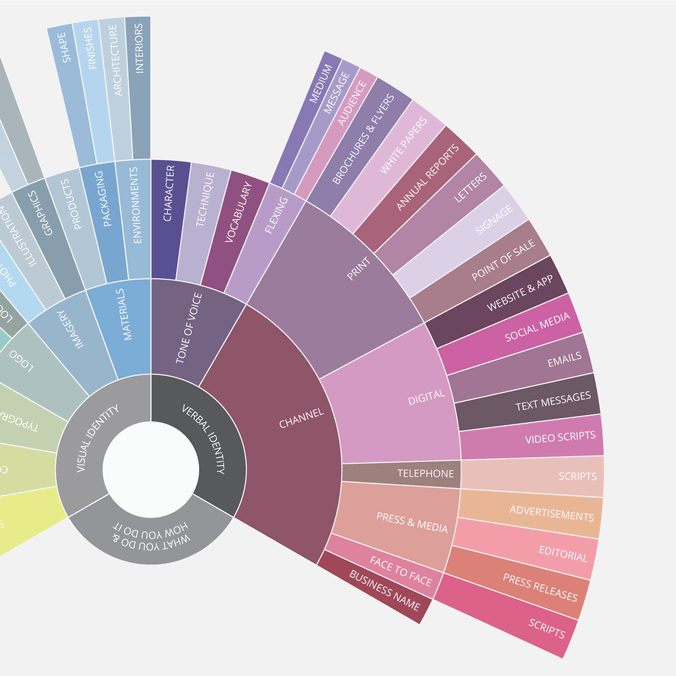
What is verbal identity?
Friday 26 June 2020
If you think of a brand as being like a person, the verbal identity is how they sound when they speak.

Friday 26 June 2020
If you think of a brand as being like a person, the verbal identity is how they sound when they speak.
If you think of a brand as being like a person, the verbal identity is how they sound when they speak. Just as it is with people, this impression will come from the combination of what the brand says – the messages, and how it says it – the tone. Although brands do speak whenever their employees interact with customers, verbal identity tends to control written communications. Another common term for verbal identity is ‘tone of voice’.
A small business usually has limited resources to promote their brand. Anything that can help convey the brand’s character and distinguish it from competitor offerings is therefore useful. A distinctive tone of voice does just that. Whatever marketing communications you undertake, if you have a distinctive tone of voice, each piece of communication will work harder for you. Just think of the contribution of Innocent’s quirky tone of voice made to its successful – and very low budget – launch and fast growth during its early years.
Tone of voice guidelines describe how to write for a brand. They provide advice on how to write well, which stops poor writing skills undermining your brand. And they offer tips on how to write for different media.
Creating a distinctive tone of voice for your brand is far harder than creating a distinctive visual identity. To create a visual identity, a brand can adopt certain colours and chooses not to use others. So EasyJet’s communications will always be dominated by orange whereas those of British Airways will always feature red and blue no matter what the media, message or audience. A brand cannot ‘own’ words in this way and this makes it difficult to carve out a truly distinctive tone of voice for a brand.
Tone of voice brand guidelines tend to define an attitude or personality the brand can demonstrate. They take direction from the brand’s values. So, if a brand has ‘human’ as a value (which a lot do), the tone of voice guidelines will contain advice on techniques for sounding human when you write. They might encourage you to ‘write like you speak’, ‘use contractions – such as “you’ll” and “we’ve”’, and ‘avoid abstruse vocabulary and complex sentences’. The trouble is, most tone of voice guidelines contain this sort of advice. As a result, they tend to offer fairly generic advice on writing well rather than techniques that will result in a noticeably distinctive tone of voice.
Given the difficulties, it’s no surprise that most brands’ verbal identities are indistinct. To differentiate requires the confidence to focus the brand’s tone on a particular attitude and insist on it in most prominent communications. Paddy Power maintains a mischievous tone, making jokes at every opportunity. (It actually employs a Head Of Mischief!) Innocent has its quirky, left-field humour created by one of its founders. More subtle verbal identity traits can be achieved by minor constraints in the use of language. Insisting on no contractions, for example, (such as always having the full, ‘you will’ rather than ‘you’ll’) will make a brand sound slightly more formal and authoritative. This helps P&O Cruises differentiate itself from its more downmarket, ‘shouty’ competitors.
Companies use tone of voice guidelines to drive consistency in the way their employees and suppliers write for their brand. If you provide no direction and let everyone write as they choose, you will have lots of different voices coming through but no clear brand voice.
Everything you need to know about writing for a brand should be in the tone of voice guidelines and they should be able to stand alone. However, changing writing habits is hard and most organisations invest in some kind of launch process and training to help employees understand and practise the new techniques required to achieve the brand voice.
The tone of voice guidelines should cover all communications – both internal and external. A social media post is written differently to an annual report and accounts, so tone of voice guidelines will offer direction on when to flex the tone to suit the media, message and audience – as well as any other variables important to the business.
This is a guest post written by Barnaby Benson, who manages the copywriting agency that shares his name. They create tone of voice schemes for brands and their agencies and have helped develop schemes for Barclays, Investec, Kantar Media, P&O Cruises and many others.
Recent posts
Featured posts

Hello! I’m Sarah, an independent typographic designer, helping businesses to communicate their unique selling points through printed marketing and communications.
I’ve been sharing my knowledge about design, typography, marketing, branding and printing since 2014. I hope you enjoy reading my blog.

Sarah Cowan